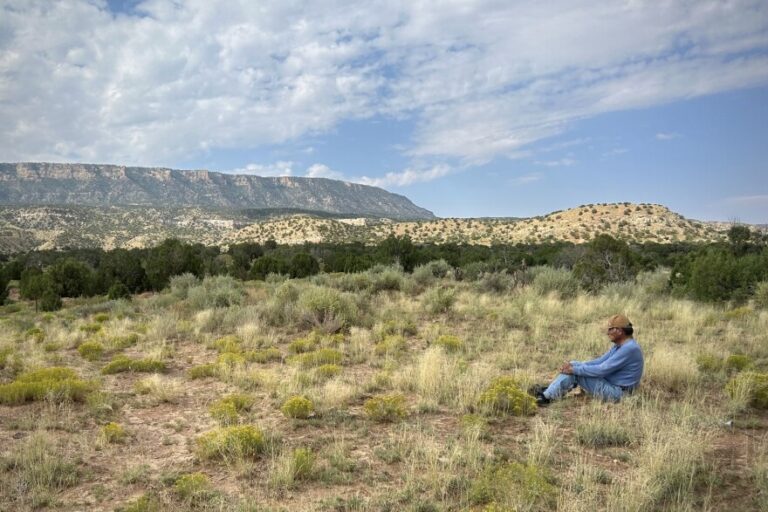Photo: Percy Deal, a resident of the Big Mountain community on Black Mesa, sits in a field near the foothills of the mountainous region on August 23, 2023. Deal and other nearby residents say their communities haven’t been consulted enough on the proposed construction of a hydropower energy project. Chris Clements/KSJD
Percy Deal, a member of the Navajo Nation, is looking up at a pale stripe of sandstone that stands out against the rim of Black Mesa in northeastern Arizona. Juniper trees speckle the steep cliffsides facing the site of a proposed hydropower project.
“All you have to do is look around here,” Deal said. “This is a very beautiful land.”
The hydropower company Nature and People First applied for preliminary permits from the Federal Energy Regulatory Commission (FERC) last year to investigate the possibility of building three pumped water storage projects on and below Black Mesa to generate electricity for nearby cities like Phoenix and Tucson. Deal and other Black Mesa residents are worried that the project could do damage to land and water that has ecological and cultural significance to both the Navajo and Hopi tribes.
“There are many sacred areas up there where our ancestors would go to pray, and would go to visit with their Creator,” he said.
Deal is a community liaison for the Navajo nonprofit Tó Nizhóní Ání, which works to protect water sources in the region. He said Nature and People First and its CEO haven’t done enough to involve nearby communities in its plans.
“It seems like from his perspective, his project is going to improve what’s here,” Deal said. “But his project is going to destroy what’s here.”
In July, environmental groups filed resolutions with FERC from 18 Navajo chapter houses and agencies that oppose the projects.
They’re concerned about potential overuse of groundwater underneath the Black Mesa region, which is still reeling from the environmental consequences of decades of extractive coal strip mining.
Pumped water storage projects like this one generate energy by letting water flow downhill from high-elevation reservoirs through a tunnel, turning a turbine as it travels to reservoirs at lower elevations.
“It seems like from his perspective, his project is going to improve what’s here. But his project is going to destroy what’s here.”
—Percy Deal, Tó Nizhóní Ání
Then, when energy prices are low, water is pumped back uphill, forming a closed-loop system that stores and releases power, like a battery.
If all three of the projects are built as planned, nine reservoirs would generate power in the region, stretching nearly 40 miles across the Navajo Nation.
“There’s a huge need in the Southwest for pump storage solutions to help deal with the intermittency of renewable energies,” said Denis Payre, CEO of Nature and People First. “Solar and wind are creating a lot of instability in the grid, and so there is a need for projects of this nature.”
Nature and People First listed the Colorado and San Juan rivers and two local sources under Black Mesa as potential options to fill and recharge its reservoirs.
However, there are a number of legal and logistical hurdles in the way of those options, like a recent Supreme Court ruling that determined the federal government has no duty to help the Navajo Nation access water […]
Full article: www.kunc.org

